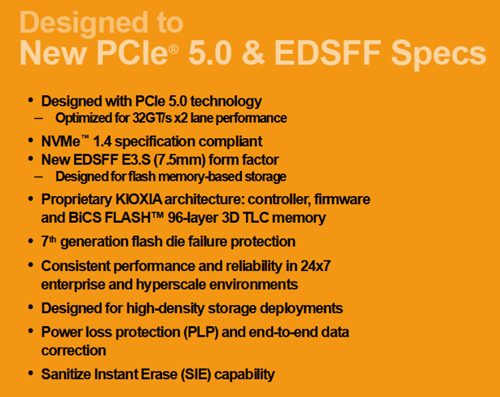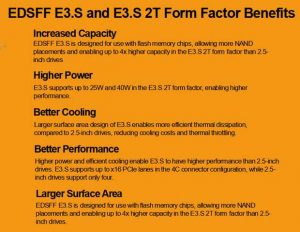Kioxia CD7 Series Up to 7.68TB SSDs With E3.S Form Factor and PCIe 5.0
Up to 6,450MB/s read and 1,050,000 random read IO/s, 75μs read and 14μs write latencies 17% and 60% lower latencies than previous PCIe 4.0 SSDs, respectively
This is a Press Release edited by StorageNewsletter.com on November 8, 2021 at 2:02 pmA new era for flash used in servers and storage is here, introduced by Kioxia America, Inc.
The company announced the CD7 Series, of Enterprise and Datacenter Standard Form Factor (EDSFF) E3.S SSDs designed with PCIe 5.0 technology (1). Building on the company’s E3.S full-function development vehicle that received a Best in Show award at last year’s Flash Memory Summit, the CD7 Series E3.S increases flash storage density per drive for optimized power efficiency and rack consolidation (2).
Breaking free from the design limitations of the 2.5-inch form factor, the EDSFF E3 family is optimized for the needs of performance, efficient servers and storage. EDSFF enables the next generation of SSDs to address future data center architectures, while supporting a variety of new devices and applications. It provides improved airflow and thermals, signal integrity benefits, and options for larger SSD capacity points. EDSFF standardizes status LEDs on the drive, which eliminates the need for LEDs on the drive carriers. Support for higher E3.S power budgets than 2.5-inch form factor SSDs and better signal integrity allows EDSFF to deliver the performance promised by PCIe 5.0 technology and beyond.
Based on the company’s f4th generation BiCS FLASH 3D flash memory technology, the CD7 Series supports x4 PCIe lanes, but is optimized for PCIe Gen5x2 performance, which is similar to PCIe Gen4x4 performance, saving 2 PCIe lanes for additional device connections. The firm is an active and contributing member to the industry development of EDSFF solutions, and is collaborating with server and storage system developers to unlock the full power of flash memory, NVMe and PCIe technologies.
“The EDSFF E3 form factor is set to redefine the way enterprise servers and storage are designed,” noted Greg Wong, founder and principal analyst, Forward Insights. “We expect the market to transition to EDSFF starting in 2022, with the introduction of PCIe 5.0 based systems.”
CD7 Series key features:
-
EDSFF E3.S form factor with capacities up to 7.68TB (3)
-
Designed to PCIe 5.0 spec and optimized for x2 PCIe lane performance
-
Using fewer PCIe lanes increases number of PCIe devices that can be supported
-
Built on BiCS Flash 3D TLC flash memory
-
Up to 6,450MB/s read throughput and 1,050,000 random read IO/s
-
75μs read and 14μs write latencies, which are 17% and 60% lower latencies than previous generation PCIe 4.0 SSDs, respectively.
“We see EDSFF as the enterprise NVMe SSD form factor of the future,” said Neville Ichhaporia, VP, SSD marketing and product management, Kioxia America. “The E3 versions, optimized for the next generation of enterprise platforms, are well suited to keep technological pace with the incremental demands data-intensive applications are placing on servers and storage. This will help customers optimize performance, cooling and storage capacity in next generation servers and storage.”
The CD7 Series SSD is sampling to select OEM customers.
Resource:
Information on EDSFF E3 technology can be found in this whitepaper from Dell, HPE and Kioxia.
(1) As of October 25, 2021, based on industry survey of publicly available information
(2) Compared to 2.5-inch form factor SSDs.
(3) Definition of capacity: Kioxia Corporation defines a megabyte 1MB as 1,000,000 bytes, 1GB as 1,000,000,000 bytes and 1TB as 1,000,000,000,000 bytes. A computer operating system, however, reports storage capacity using powers of 2 for the definition of 1Gb = 2^30 bits = 1,073,741,824 bits, 1GB = 2^30 bytes = 1,073,741,824 bytes and 1TB = 2^40 bytes = 1,099,511,627,776 bytes and therefore shows less storage capacity. Available storage capacity (including examples of various media files) will vary based on file size, formatting, settings, software and operating system, and/or pre-installed software applications, or media content. Actual formatted capacity may vary.















 Subscribe to our free daily newsletter
Subscribe to our free daily newsletter
